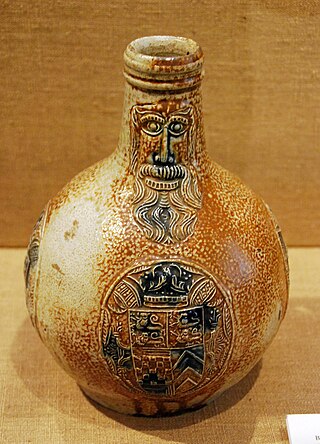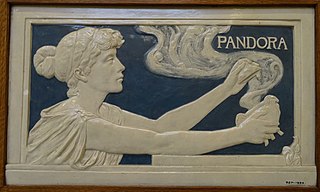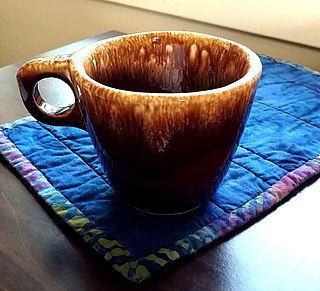
The J. B. Owens Pottery Company, informally known as Owens Pottery, was an American art pottery and tile company that flourished for a few years around the turn of the 20th century.

The J. B. Owens Pottery Company, informally known as Owens Pottery, was an American art pottery and tile company that flourished for a few years around the turn of the 20th century.
Owens Pottery was founded by J. B. Owens in Roseville, Ohio, in 1885. [1] In 1891 it moved to Zanesville, where Owens built a new factory on a site with its own rail spur. [2] It began producing art pottery in 1896, when it introduced the Utopian line with botanical decorations under a brown glaze. [3] All told, it produced some four dozen different lines of art pottery, with types ranging from vases, bowls, and pitchers to umbrella stands and lamps. Popular lines included Utopian, Lightweight, Lotus, Henri Deux, and Matte Green. [3] [4] Especially distinctive lines include Red Flame (featuring slip decoration under a red glaze), Mission (depicting Spanish missions), and Coralene (featuring small bead decorations). [5]
The pottery won awards and was often compared to the work of rivals like Rookwood Pottery, Roseville Pottery, and Weller Pottery, all of which were also based in Ohio. [3] Potters who were associated with Owens Pottery over the years include Albert Radford, W. A. Long (who founded Lonhuda), Frank Ferrell, Karl Langenbeck, John J. Herold, Herb Hugo, and John Lessell. [3]
A fire destroyed most of the Zanesville factory in 1902, but Owens rebuilt on the same site and took the opportunity to double in size to 11 kilns. [2] Around the same time, Owens bought the New York–based American Art-Ceramic Company. [2]
In 1905, Owens Pottery began making tiles, and this line quickly grew to dominate production, with the result that the Zanesville Tile Company was incorporated to handle this end of the business. [2] Around 1907 Owens sold most of his stake in both companies, only to buy them back by 1909 after other investors pushed the tile business into receivership. [2] Shortly thereafter, he set up a new company, J. B. Owens Floor & Wall Tile, with a new factory across the street from his former operations. [2] For a few years the new company made both art pottery and tiles, but within a few years it stopped producing art pottery altogether. [2] The company name was changed again, to the Empire Floor and Wall Tile Company. [2] Owens also had stakes in other ceramic companies in Ohio and New Jersey, and he was awarded over 20 patents, most of them related to the design for a tunnel kiln. [2]
The Empire factory burned in 1928 and Owens effectively went out of business the following year, though his companies were involved in lawsuits for several more decades. [3] [2]

Delftware or Delft pottery, also known as Delft Blue or as delf, is a general term now used for Dutch tin-glazed earthenware, a form of faience. Most of it is blue and white pottery, and the city of Delft in the Netherlands was the major centre of production, but the term covers wares with other colours, and made elsewhere. It is also used for similar pottery, English delftware.

Porcelain is a ceramic material made by heating raw materials, generally including kaolinite, in a kiln to temperatures between 1,200 and 1,400 °C. The greater strength and translucence of porcelain, relative to other types of pottery, arise mainly from vitrification and the formation of the mineral mullite within the body at these high temperatures. End applications include tableware, decorative ware such as figurines, and products in technology and industry such as electrical insulators and laboratory ware.

Salt-glaze or salt glaze pottery is pottery, usually stoneware, with a ceramic glaze of glossy, translucent and slightly orange-peel-like texture which was formed by throwing common salt into the kiln during the higher temperature part of the firing process. Sodium from the salt reacts with silica in the clay body to form a glassy coating of sodium silicate. The glaze may be colourless or may be coloured various shades of brown, blue, or purple.

Frederick Hurten Rhead (1880–1942) was a ceramicist and a major figure in the Arts and Crafts movement. A native of England, he worked as a potter in the United States for most of his career. In addition to teaching pottery techniques, Rhead was highly influential in both studio and commercial pottery. He worked for the Roseville Pottery, established his own Rhead Pottery (1913–1917), and in 1935 designed the highly successful Fiesta ware for Homer Laughlin China Company.

The Della Robbia Pottery was a ceramic factory founded in 1894 in Birkenhead, near Liverpool, England. It closed in 1906. Initially it mostly made large pieces with high artistic aspirations, especially relief panels for architectural use, but also ornamental vessels and plates, intended for display rather than use.

Mintons was a major company in Staffordshire pottery, "Europe's leading ceramic factory during the Victorian era", an independent business from 1793 to 1968. It was a leader in ceramic design, working in a number of different ceramic bodies, decorative techniques, and "a glorious pot-pourri of styles - Rococo shapes with Oriental motifs, Classical shapes with Medieval designs and Art Nouveau borders were among the many wonderful concoctions". As well as pottery vessels and sculptures, the firm was a leading manufacturer of tiles and other architectural ceramics, producing work for both the Houses of Parliament and United States Capitol.

Ceramic glaze, or simply glaze, is a glassy coating on ceramics. It is used for decoration, to ensure the item is impermeable to liquids and to minimise the adherence of pollutants.

Hull pottery began production in 1905 in Crooksville, Ohio, under the leadership of Addis Emmet (A.E.) Hull. The Hull Pottery Company's early lines consisted of common utilitarian stoneware, semi-porcelain dinnerware and decorative tile. The company quickly established a firm market and enjoyed an excellent reputation for producing quality ceramics.

The Roseville Pottery Company was an American art pottery manufacturer in the 19th and 20th centuries. Along with Rookwood Pottery and Weller Pottery, it was one of the three major art potteries located in Ohio around the turn of the 20th century. Though the company originally made simple household pieces, the Arts and Crafts–inspired designs proved popular, and Roseville pieces are now sought after by collectors.

In 1872, Samuel A. Weller founded Weller Pottery in Fultonham, Ohio, United States. Originally, his business consisted of a small cabin and one beehive kiln, and Weller produced flower pots, bowls, crocks, and vases. By 1905, Weller Pottery was the largest pottery in the country. It mass-produced art pottery until about 1920, and it produced commercial lines until the pottery closed in 1948.

Art pottery is a term for pottery with artistic aspirations, made in relatively small quantities, mostly between about 1870 and 1930. Typically, sets of the usual tableware items are excluded from the term; instead the objects produced are mostly decorative vessels such as vases, jugs, bowls and the like which are sold singly. The term originated in the later 19th century, and is usually used only for pottery produced from that period onwards. It tends to be used for ceramics produced in factory conditions, but in relatively small quantities, using skilled workers, with at the least close supervision by a designer or some sort of artistic director. Studio pottery is a step up, supposed to be produced in even smaller quantities, with the hands-on participation of an artist-potter, who often performs all or most of the production stages. But the use of both terms can be elastic. Ceramic art is often a much wider term, covering all pottery that comes within the scope of art history, but "ceramic artist" is often used for hands-on artist potters in studio pottery.

Rookwood Pottery is an American ceramics company that was founded in 1880 and closed in 1967, before being revived in 2004. It was initially located in the Over-the-Rhine neighborhood in Cincinnati, Ohio, and has now returned there. In its heyday from about 1890 to the 1929 Crash, it was an important manufacturer, mostly of decorative American art pottery made in several fashionable styles and types of pieces.

Franciscan Ceramics are ceramic tableware and tile products produced by Gladding, McBean & Co. in Los Angeles, California, US from 1934 to 1962, International Pipe and Ceramics (Interpace) from 1962 to 1979, and Wedgwood from 1979 to 1983. Wedgwood closed the Los Angeles plant, and moved the production of dinnerware to England in 1983. Waterford Glass Group plc purchased Wedgwood in 1986, becoming Waterford Wedgwood. KPS Capital Partners acquired all of the holdings of Waterford Wedgwood in 2009. The Franciscan brand became part of a group of companies known as WWRD, an acronym for "Wedgwood Waterford Royal Doulton." WWRD continues to produce the Franciscan patterns Desert Rose and Apple.

California pottery includes industrial, commercial, and decorative pottery produced in the Northern California and Southern California regions of the U.S. state of California. Production includes brick, sewer pipe, architectural terra cotta, tile, garden ware, tableware, kitchenware, art ware, figurines, giftware, and ceramics for industrial use. Ceramics include terra cotta, earthenware, porcelain, and stoneware products.

The Shawnee Pottery Company was a manufacturing company best known for producing Corn King pottery and the Pennsylvania Dutch lines of pottery. Both of these lines are considered highly collectible.
Samuel Augustus Weller, one of the pioneer pottery manufacturers of Ohio in the United States, founded the S.A. Weller Pottery in Fultonham, Ohio, in 1872. In 1882 he moved the business to Zanesville, Ohio, and for more than a half-century Weller Pottery produced both utilitarian pieces and more decorative art pottery lines.

Ceramic art is art made from ceramic materials, including clay. It may take varied forms, including artistic pottery, including tableware, tiles, figurines and other sculpture. As one of the plastic arts, ceramic art is a visual art. While some ceramics are considered fine art, such as pottery or sculpture, most are considered to be decorative, industrial or applied art objects. Ceramic art can be created by one person or by a group, in a pottery or a ceramic factory with a group designing and manufacturing the artware.

American art pottery refers to aesthetically distinctive hand-made ceramics in earthenware and stoneware from the period 1870-1950s. Ranging from tall vases to tiles, the work features original designs, simplified shapes, and experimental glazes and painting techniques. Stylistically, most of this work is affiliated with the modernizing Arts and Crafts (1880-1910), Art Nouveau (1890–1910), or Art Deco (1920s) movements, and also European art pottery.
Wheatley Pottery Company produced ornamental vases, lamps, and ceramic tile in Cincinnati, Ohio. Their autumn leaf tiles were used on the Franklin Building, along Printer's Row in Chicago. The MET has an earthenware umbrella stand from the company in its collection.

White Cloud Farms Pottery, also referred to as White Cloud Pottery, was a 20th-century American ceramics studio (1924–1957) located in Rock Tavern, New York, Orange County, some 65 miles north of Manhattan.